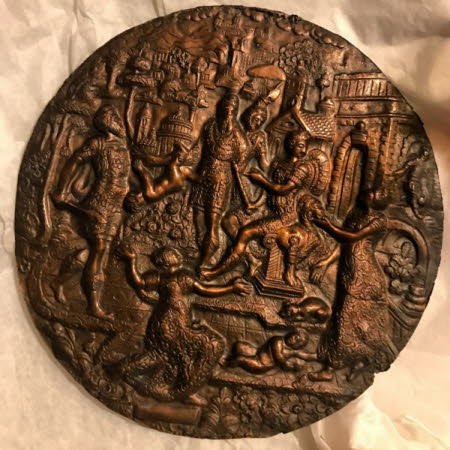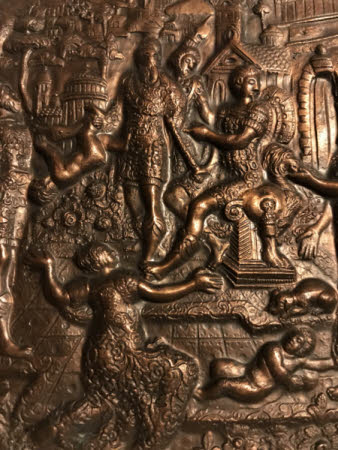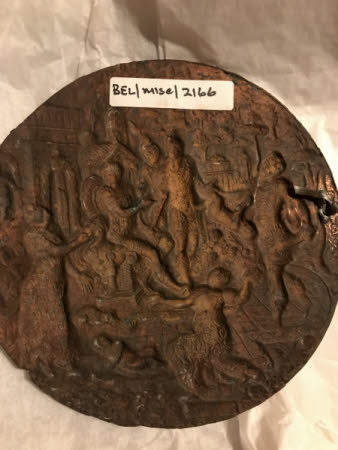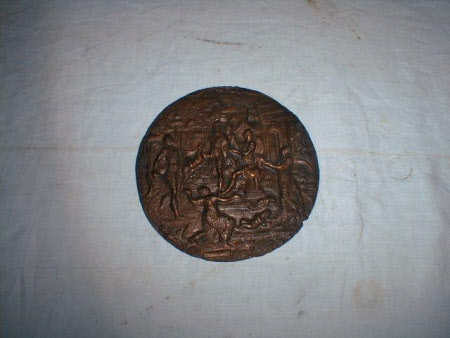The Judgement of Solomon
after Hans Jamnitzer II (1539 - 1603)
Category
Art / Sculpture
Date
1838 - 1900
Materials
Copper electrotype
Measurements
135 mm (Diameter)
Place of origin
Great Britain
Order this imageCollection
Belton House, Lincolnshire
NT 435854
Summary
Copper electrotype, The Judgement of Solomon, probably British (English) School, after Hans Jamnitzer (1539 - 1603), after 1838. A copper electrotype plaquette depicting the Judgement of Solomon after Hans Jamnitzer.
Full description
The plaquette depicts the Judgement of Solomon: a Hebraic story in which two women claim to be the mother of King Solomon’s child and are tested. Solomon, seated on the throne at upper right, proposes that the child, held upside down by the swordsman at left, be cut into two, each woman receiving half. His true mother, kneeling to the left of another dead infant, beseeches Solomon to be merciful, begging that the child be committed to the care of her rival (right) rather than being severed to death by the swordsman. Solomon’s strategy exposes the true mother from the false, in a story which has become an archetypal example of impartiality in judgement. The scene is set in the courtyard of a palace, possibly Solomon’s Temple, with churches and a mountainous forested landscape beyond. This electrotype medallion is after a well-known German plaquette attributed to Hans Jamnitzer or his workshop, dated to around 1575. Other versions can be found, for example, at the Rijksmuseum (BK-NM-3082) and at the Ashmolean Museum, where the plaquette is cast into the centre of a pewter dish (WA OA162). The design is not directly taken from an engraving, however it appears to draw some compositional elements from The Judgement of Solomon after Frans Floris (1519/1520 –70); see, for example, the engraving after Floris by Dirk Volkertsz Coornhert (1522 - 90) in the British Museum, London (BM 1935,0520.85). The electrotype method was invented in 1838 to reproduce quickly and accurately works of art in metal. ‘The technique involves making a negative mould of the object from wax or fine clay. This is then dusted with a very fine conductive powder (usually graphite), after which a metal (usually copper) is electroplated onto the surface of the mould, forming a thin metal shell, with what is often a remarkably accurate image of the original object.’ (Warren 2014, III, Appendix A, p.1093). A copper electrotype of Jamnitzer’s Judgement of Solomon decorates the lid of a Victorian inkwell by Elkington Mason & Co. (see catalogue of Woolley and Wallis, Furniture, Works of Art & Clocks, 12 April 2017, lot 325). Alice Rylance-Watson October 2018
Provenance
Purchased with a grant from the National Heritage Memorial Fund (NHMF) from Edward John Peregrine Cust, 7th Baron Brownlow, C. St J. (b.1936) in 1984.
Credit line
Belton House, The Brownlow Collection (acquired with the help of the National Heritage Memorial Fund by the National Trust in 1994)
Makers and roles
after Hans Jamnitzer II (1539 - 1603), goldsmith Hans Jamnitzer II (1539 - 1603), metalworker
References
Warren 2014: Jeremy Warren, Medieval and Renaissance Sculpture in the Ashmolean Museum, Volume III, Plaquettes, Oxford 2014, no.457, pp.990-92, 1093. Weber 1975: Ingrid Weber, Deutsche, Niederländische und Französische Renaissanceplaketten 1500-1650, 2 vols., Munich 1975, no.282, pp.164-5



